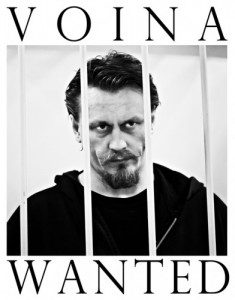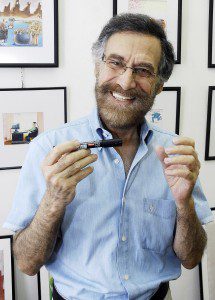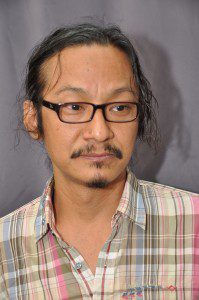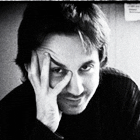Index relies entirely on the support of donors and readers to do its work.
Help us keep amplifying censored voices today.
Self-censorship has poisoned Russian media, art and other spheres.
In the past few years, criminal prosecution of artists and new laws have made it clear for those who criticise the Kremlin or Russian Orthodox Church in their creative work, will face consequences for portraying either of these institutions negatively.
Just last week, the State Duma passed two controversial laws in the first hearing. One forbids obscene language in movies, books, TV, and radio during mass public events. The other stipulates criminal punishment — including five years in prison — for “insulting believers’ feelings”. Both laws, as far as human rights activists are concerned, limit artists’ freedom of expression, and encourage self-censorship.
Index spoke to three notable artists to find out how the art community deals with self-censorship, and the ever-increasing restrictions on freedom of expression in Russia.
Artyom Loskutov, an artist from Novosibirsk, is famous for holding “monstrations” — flash mobs with absurd slogans like “Tanya, don’t cry” and “Who’s there?”. In 2009, he was arrested on drug possession charges, but he claims that the marijuana was planted on him by police. A blood test proved that he had not taken any drugs, and his fingerprints were not found on the package. Three years on, he faced three administrative cases, and paid a 1000 rouble fine for creating icon-like images of Pussy Riot members Nadezhda Tolokonnikova and Maria Alekhina and placing them on billboards. He was accused of insulting believers. He is currently appealing the court ruling in the European Court of Human Rights.
The artist told Index that the cases against him are acts of censorship, but vows to remain defiant and continue with his work:
The icons idea concerned two kinds of mothers: one mother is honoured as a saint, the two others — Tolokonnikova and Alekhina — were thrown in prison. The authorities, including the court, are becoming more insane, and one wouldn’t want to cause persecutions. But I can’t say that given that, I refuse to implement any of my plots. In the 90s my generation felt that we had nothing, except free speech, and all the 2000s attempts to take it away meet nothing but incomprehension
In 2010, The prosecutor’s office in Moscow’s Bassmany district examined the works of Moscow-based artist Lena Hades, “Chimera of Mysterious Russian Soul” and “Welcome to Russia”. Russian nationalists appealed to the authorities claiming these paintings insult Russians. The case did not go to court, but Hades told Index that Russian galleries feared exhibiting her paintings after the incident.
“Galleries are afraid of financial sanctions,” Hades says, “Although 95 per cent of my paintings are about philosophy rather than about social events, they are only exhibited in Tretyakov Gallery and Moscow Museum of Modern Art”.
Despite reduced chances of her work being exhibited, Hades still painted Pussy Riot’s members, and went on a 25-day hunger strike against their prosecution. The artist is no fan of self-censorship, even if it comes at a cost. According to her, no artist that responds to reality can accept self-censorship:
This is not courage, this is aristocratic luxury of doing what you want. Self-censorship is more harmful for a modern Russian artist than censorship. He is frightened of scaring away galleries and buyers and prefers to paint landscapes with cows — anything far enough from real social life
Artist Boris Zhutovsky has a long-standing relationship with censorship. In 1962, he was slammed by then Soviet leader Nikita Khrushchev, who banned work by Zhutovsky and his colleagues. For several years following the incident, the artist faced difficulties in finding employment, and his work was not exhibited in the USSR.
Zhutovsky continues to court controversy today: in the past few years he has painted the trials of Russia’s most well-known political prisoners, businessmen Mikhail Khodorkovsky and Platon Lebedev, who were first convicted in 2005. He explained Russia’s culture of self-censorship to Index:
Self-censorship is based on fear, and the amplitude of this fear has changed throughout my life. In the times of Stalin, it was the fear of the Gulag and execution. In the times of Khruschev it was the fear of loosing a job or a country – a person could be forced to leave the Soviet Union. After Perestroika the fear shrank, and now the fear which nourishes self-censorship is the fear to anger your boss
He is optimistic that a younger generation of artists will not accept self-censorship as a standard, as the the era of Putin is far from that of Stalin, but only time will tell.
Self-censorship has poisoned Russian media, art and other spheres.
In the past few years, criminal prosecution of artists and new laws have made it clear for those who criticise the Kremlin or Russian Orthodox Church in their creative work, will face consequences for portraying either of these institutions negatively.
Just last week, the State Duma passed two controversial laws in the first hearing. One forbids obscene language in movies, books, TV, and radio during mass public events. The other stipulates criminal punishment — including five years in prison — for “insulting believers’ feelings”. Both laws, as far as human rights activists are concerned, limit artists’ freedom of expression, and encourage self-censorship.
Index spoke to three notable artists to find out how the art community deals with self-censorship, and the ever-increasing restrictions on freedom of expression in Russia.
Artyom Loskutov, an artist from Novosibirsk, is famous for holding “monstrations” — flash mobs with absurd slogans like “Tanya, don’t cry” and “Who’s there?”. In 2009, he was arrested on drug possession charges, but he claims that the marijuana was planted on him by police. A blood test proved that he had not taken any drugs, and his fingerprints were not found on the package. Three years on, he faced three administrative cases, and paid a 1000 rouble fine for creating icon-like images of Pussy Riot members Nadezhda Tolokonnikova and Maria Alekhina and placing them on billboards. He was accused of insulting believers. He is currently appealing the court ruling in the European Court of Human Rights.
The artist told Index that the cases against him are acts of censorship, but vows to remain defiant and continue with his work:
The icons idea concerned two kinds of mothers: one mother is honoured as a saint, the two others — Tolokonnikova and Alekhina — were thrown in prison. The authorities, including the court, are becoming more insane, and one wouldn’t want to cause persecutions. But I can’t say that given that, I refuse to implement any of my plots. In the 90s my generation felt that we had nothing, except free speech, and all the 2000s attempts to take it away meet nothing but incomprehension
In 2010, The prosecutor’s office in Moscow’s Bassmany district examined the works of Moscow-based artist Lena Hades, “Chimera of Mysterious Russian Soul” and “Welcome to Russia”. Russian nationalists appealed to the authorities claiming these paintings insult Russians. The case did not go to court, but Hades told Index that Russian galleries feared exhibiting her paintings after the incident.
“Galleries are afraid of financial sanctions,” Hades says, “Although 95 per cent of my paintings are about philosophy rather than about social events, they are only exhibited in Tretyakov Gallery and Moscow Museum of Modern Art”.
Despite reduced chances of her work being exhibited, Hades still painted Pussy Riot’s members, and went on a 25-day hunger strike against their prosecution. The artist is no fan of self-censorship, even if it comes at a cost. According to her, no artist that responds to reality can accept self-censorship:
This is not courage, this is aristocratic luxury of doing what you want. Self-censorship is more harmful for a modern Russian artist than censorship. He is frightened of scaring away galleries and buyers and prefers to paint landscapes with cows — anything far enough from real social life
Artist Boris Zhutovsky has a long-standing relationship with censorship. In 1962, he was slammed by then Soviet leader Nikita Khrushchev, who banned work by Zhutovsky and his colleagues. For several years following the incident, the artist faced difficulties in finding employment, and his work was not exhibited in the USSR.
Zhutovsky continues to court controversy today: in the past few years he has painted the trials of Russia’s most well-known political prisoners, businessmen Mikhail Khodorkovsky and Platon Lebedev, who were first convicted in 2005. He explained Russia’s culture of self-censorship to Index:
Self-censorship is based on fear, and the amplitude of this fear has changed throughout my life. In the times of Stalin, it was the fear of the Gulag and execution. In the times of Khruschev it was the fear of loosing a job or a country – a person could be forced to leave the Soviet Union. After Perestroika the fear shrank, and now the fear which nourishes self-censorship is the fear to anger your boss
He is optimistic that a younger generation of artists will not accept self-censorship as a standard, as the the era of Putin is far from that of Stalin, but only time will tell.
 Voina, meaning “War”, is a collective of radical Russian anarchist artists who combine political protest and performance art.
Voina, meaning “War”, is a collective of radical Russian anarchist artists who combine political protest and performance art.
Voina’s carries out actions directed against the authorities. In June 2010, members painted a 65-metre phallus on a drawbridge in St Petersburg which, when raised, faced the city headquarters of the federal security service.
Voina members Vorotnikov and Leonid Nikolayev were imprisoned from November 2010 to February 2011 in connection with an anti-corruption protest and, in July 2011, Russian police issued an international arrest warrant for Vorotnikov. A warrant for the arrest of fellow artist Natalia Sokol was issued in December 2011.
 AiWeiwei is a Chinese artist and activist whose work incorporates social and political activism. He has investigated corruption and cover-ups and openly criticised the Chinese government’s record on human rights.
AiWeiwei is a Chinese artist and activist whose work incorporates social and political activism. He has investigated corruption and cover-ups and openly criticised the Chinese government’s record on human rights.
Ai’s 81-day detention in 2011 caused international uproar. He was arrested in April, alongside several of his friends and colleagues. Since the Chinese authorities released him on bail in June 2011, he has been fined $2.4 million in back taxes and penalties. Though officials arrested Ai for alleged economic crimes, supporters say he was punished for his activism and vocal critiques of the government. He paid a $1.3 million bond with loans from supporters, who contributed online and in person and even throwing cash over the walls of his studio in Beijing.
In November 2011, after Ai announced that authorities were investigating his cameraman for pornography in connection with photos that featured the artist and four women naked, internet users responded tweeting nude photos of themselves in support.
 Syrian cartoonist Ali Ferzat has been called “an icon of freedom in the Arab world”. He has spent decades ridiculing dictators in more than 15,000 caricatures. His depictions of President Assad and the police state have helped galvanise revolt in Syria.
Syrian cartoonist Ali Ferzat has been called “an icon of freedom in the Arab world”. He has spent decades ridiculing dictators in more than 15,000 caricatures. His depictions of President Assad and the police state have helped galvanise revolt in Syria.
In August 2011, Ferzat was wrenched from his vehicle in central Damascus by pro-Assad masked gunmen who beat him badly and broke his hands. Passers-by found Ferzat dumped at the side of a road; his briefcase and the drawings inside it had been confiscated by his attackers.
Ferzat earned regional and international recognition in the 1980s with stinging cartoons of officials, autocrats and dictators including Saddam Hussein and Muammar Gaddafi. Saddam Hussein called for Ferzat’s death in 1989 after an unfavourable portrait of him was exhibited in Paris and Ferzat’s cartoons have been banned in numerous Arabic countries.
 Min Htin Ko Ko Gyi, a poet, filmmaker and screenwriter, co-founded Burma’s inaugural Arts of Freedom Film Festival, which took place in early January 2012.
Min Htin Ko Ko Gyi, a poet, filmmaker and screenwriter, co-founded Burma’s inaugural Arts of Freedom Film Festival, which took place in early January 2012.
Burmese citizens were invited to create a short film on the theme of freedom. Despite the state media’s refusal to cover the announcement, Ko Ko Gyi and his organisers received 188 submissions. Thousands gathered in Rangoon under the banner “Free Art, free thought, freedom”, to watch the selected films. More than 7,000 attendees voted for Cut This Scene to win one of five awards. The film is a satire of a government censorship committee struggling to set the criteria by which to censor films.
 Russian guerrilla artists from the Voina art collective are facing criminal prosecution for their controversial brand of political street art. Nick Sturdee reports on the widespread frustration that has fostered the movement
Russian guerrilla artists from the Voina art collective are facing criminal prosecution for their controversial brand of political street art. Nick Sturdee reports on the widespread frustration that has fostered the movement
(more…)